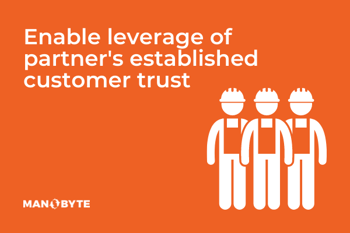Selling Your Building Materials Through Indirect Distribution Channels
Kevin Dean

Interested in a way to increase your revenue without having to rely solely on an in-house sales department? Salespeople are great, but they only have so much selling time in a day. Even if you hire the most driven people and provide them with the necessary tools to increase productivity, it still comes down to having enough time.
The answer could be to hire more sales reps. Some businesses choose to go that route. That could be the answer, but there’s another, more efficient solution. Plus, hiring more salespeople and taking into account the training process that goes with it, can be very costly and will cut into your margins.
An indirect sales channel could be just the solution when you’re looking for an effective, low-risk sales model that can efficiently scale your building materials business.
What is Your Distribution Strategy?
While the most common form of building materials marketing is through one step and two step distributors, you do have more than one distribution strategy choice when selling your building materials.
You could sell your construction products via
- Direct sales online via an eCommerce website
- Direct sales via offline methods
- Indirect sales online via third-party eCommerce marketplaces
- Indirect sales via one step distributors like product dealers and lumber yards
- Indirect sales via big-box stores like Lowes, Home Depot, Big R, etc
- Indirect sales via two step distributors like builders, contractors, and independent sales reps.
As the lines between B2B selling and B2C selling continue to blur more and more, consider the most effective ways to sell your construction materials.
Direct Versus Indirect Sales
When implementing a direct sales strategy to sell your construction products, you are employing your own, in-house team of salespeople to sell directly to the end consumer, either through your own location or online. An example of a direct sales channel versus an indirect sales channel would be Nike. If you go to a Nike store or the Nike website to purchase a pair of their shoes you would be using a direct sales channel. Buying them through websites like Zappos and Amazon, or purchasing them at any other sporting goods stores is an example of an indirect sales channel. When selling your materials, you may have online purchasing options available to sell direct to consumer - that's direct sales. Or you may have a network of channel partners who stock and sell your products through their marketing platforms and sales teams. This in indirect sales.
What is Indirect Sales?
Most simply put, indirect sales is a strategy that uses third party distributors, resellers, wholesalers, dealers etc. to sell your product for you. Specifically within the building materials space, this involves developing indirect distribution relationships with
- Construction Materials Distributors, such as home centers and hardware stores
- Materials Resellers, such as residential and commercial specialty supply stores
- Construction Supply Wholesalers
- Building Supply Dealers, such as lumber yards and product showrooms
- Architects, Builders, and Contractors who specify your products into their construction drawings
Efficiency of Indirect Sales for Materials Manufacturers
Efficiency is just one of the many benefits that comes with using an indirect sales channel. For example, you can drastically cut costs while bringing in the same amount of revenue using one channel manager paired with numerous channel partners as opposed to the fix or six internal building materials sales reps you'd hire instead. This saves money and manpower, as opposed to the five or six salespeople you'd hire instead. After you’ve created your strategy, developed your channel marketing materials, and worked out the kinks, it’s often times more profitable to onboard new partners than it is to hire a new salesperson.
Built-in trust, rapid testing, product maturity, and customer success are just some of the many benefits that come with integrating an indirect sales channel strategy into your business.
Factors to Consider Before Integrating an Indirect Sales Channel
Keep in mind that indirect sales channels can be a very powerful way to increase revenue and efficiency within your company, but only if you’re selling the right kinds of products. Indirect distribution is often an ideal channel to get specified into more construction drawings and sell more. Here are some deciding factors to think about to ensure it's a good approach for your specific products and brand:
 1. Product maturity
1. Product maturity
The current success of your construction materials product is determined by which stage of the product life cycle it lies in. For instance, if your product is fairly new and an emerging disruptor in the construction space, direct sales will be better at first to get the quick feedback you need to make the necessary improvements. Once proven, you can start expanding into indirect distribution channels and live in that space until buyer behavior substantially changes.
 2. Easily Marketed
2. Easily Marketed
To be easily marketed means that your product is uncomplicated and able to be sold quickly without a lot of research and touch points. This is an ideal scenario when you're looking to sell through indirect distribution channels because your partner's sales reps can easily grasp the functions and benefits of your product and identify for their customers when your product is best to solve their particular problem. On the other hand, if your offering is full of intricacies and needs to be explained one-on-one to a potential customer in order to be used, an indirect sales channel is probably not the right choice for you. A good litmus test for this would be to determine whether or not your average Joe employee at Lowe's or Home Depot would know exactly when to point customers to your product and it fully solve their problem.
 3. Well-Researched Sales Process
3. Well-Researched Sales Process
It is imperative to have a well-designed sales process when deciding whether or not to implement an indirect sales channel. One where you can describe your buyer personas, pain points, buying triggers, average sales cycles etc. quickly and easily. Each of those aspects are crucial to making sure your indirect sales channel partner has all of the information needed to effectively identify and then sell to your buyers. By accurately defining your target buyer, you can, for example opt NOT to focus on indirect sales channels if your buyer persona is a DIYer. In that case, you'd be better off focusing your marketing and sales efforts on inbound content strategies.
Why Building Materials Manufacturers Choose Indirect Sales Channels
Even if your company already has a successful direct sales program, many still choose to incorporate indirect sales channels into their wholistic channel program strategy. Some manufacturers may choose to focus solely on these channels, but that’s dependent on the type of business it is. Below are some of the key reasons companies choose to implement an indirect sales channel strategy:
 1. Lower Sales and Marketing Costs
1. Lower Sales and Marketing Costs
As opposed to using an in-house direct sales team, indirect sales channels cost significantly less in overhead costs. They also capitalize on the effort and cost a partner has put into building the business and its client base. Most of your costs in this strategy will come from developing partner materials and resources to house in your PRM, communicating product features, benefits, and changes to your partners, monitoring partner goal completion and offering incentives.
 2. Established Trust
2. Established Trust
Many salespeople have a hard time with the concept of cold calling. One of the most difficult aspects of selling a product is establishing trust. Indirect sales channels allow you to use the trust and relationships your partner has already established. Since your partner has already established relationships with potential clients, you’re able to create a brand presence with little effort. Then your focus can be on establishing trust with your partners and ensuring your brand supports their delivery of quality to the consumer.
 3. Lower Risk
3. Lower Risk
Indirect sales channels are a relatively low-risk way to try out and evaluate a new market. This is due to their higher efficiency and lower costs. You’re able to try new campaigns, products, packages, and promotions with a partner. You can analyze what messages resonate and what content enables a buying decision to be made. Further, using the right sales and marketing tools will enable you to track all of this one place. You’d be risking much more if you were to try those things in direct sales.
Would an Indirect Sales Channel Increase Materials Sales?
As with all undertaking worth taking, indirect sales channels can involve a significant time investment upfront with the proof that in short order, it has the potential to completely transform your sales funnel. You can broaden your market much more easily than you could relying solely on direct sales because of the trust your partners have already built up with their customers. You’re able to experiment with less risk, while, at the same time, having the flexibility you need based on your goals and the size of your business.
In the end, indirect sales channels give you the ability to form new business relationships that will continue to benefit your business for years to come. Interested in getting maximum returns from your indirect sales partners? Let's chat!
Ready to Dive In?
Work with our team of HubSpot experts and watch us take clunky systems, tech stacks, websites, and portals and turn them into tailored, intelligent workflows that deliver business outcomes.



